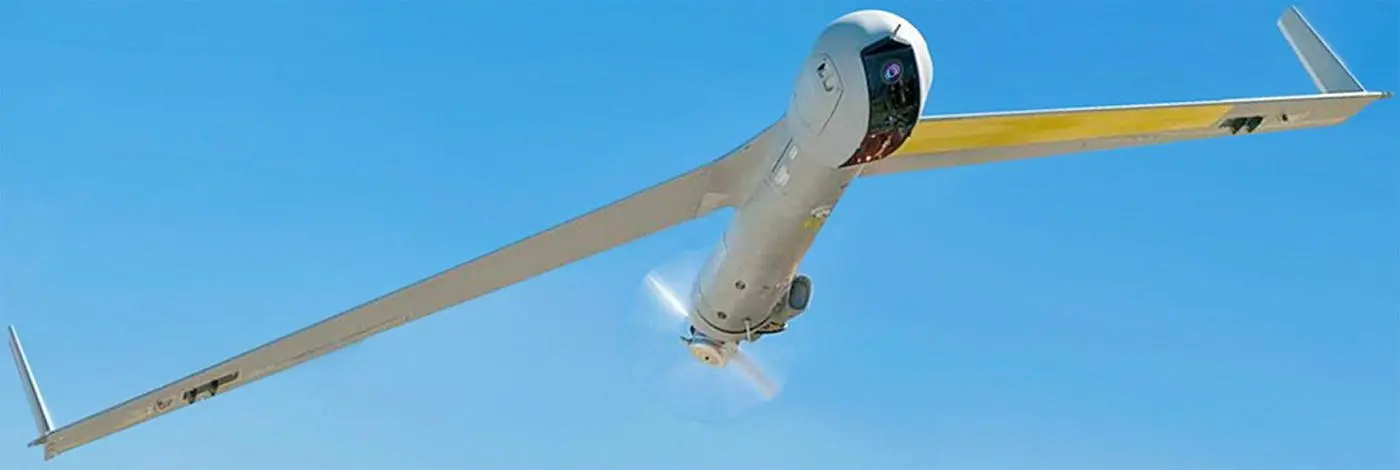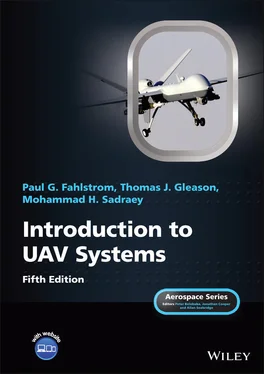What we will call “small UAVs” have at least one dimension of greater than 50 cm (19.7 in) and go up to dimensions of a meter or two. Many of these UAVs have the configuration of a fixed‐wing model airplane and are hand‐launched by their operator by throwing them into the air much as we launch a toy glider. In the past ten years, the quadcopters for this class – with VTOL capability – have been operational and gained a significant market.
Examples of small UAVs include the US AeroVironment Raven and the Turkish Byraktar Mini, both conventional fixed‐wing vehicles. There are also a number of rotary‐wing and multi‐copter UAVs in this size grouping, but they are basically scaled‐down versions of the medium rotary‐wing systems discussed in the following section and we do not offer an example in this group.
The RQ‐11A Raven is an example of a UAV that is in the “model airplane” size range. It has a 1.4‐m (4.6‐ft) wingspan and is about 1 m (3.3 ft) long. It weighs only a little less than 4.4 lb (mass of 2 kg) and is launched by being thrown into the air by its operator in much the same way that a toy glider is put into flight. It uses electrical propulsion and can fly for nearly an hour and a half. The Raven and its control “station” can be carried around by its operator on his/her back. It carries gimbaled visible, near‐infrared (NIR), and thermal imaging systems for reconnaissance as well as a “laser illuminator” to point out target to personnel on the ground. (Note that this is not a laser for guiding laser‐guided weapons, but more like a laser pointer, operating in the NIR to point things out to people using image‐intensifier night‐vision devices.)
The latest model, the RQ‐11B Raven, was added to the US Army’s Small UAV (SUAV) program in a competition that started in 2005. Built by AeroVironment, the Raven B includes a number of improvements from the earlier Raven A, including improved sensors, a lighter Ground Control System, and the addition of the onboard laser illuminator. Endurance was improved, as was interoperability with battlefield communication networks.
The Bayraktar small UAV was developed by Baykar Makina, a Turkish company. It is a conventionally configured, electrically powered AV somewhat larger than the Raven, with a length of 1.2 m (3.86 ft), wingspan of 2 m (5.22 ft), and weight of 5 kg (105 lb) at takeoff. It is advertised to have a spread‐spectrum, encrypted data link, which is a highly desirable, but unusual, feature in an off‐the‐shelf UAV. The data link has a range of 20 km (12.4 miles), which would limit the operations to that range, although it may depend on the local geography and where the ground antenna is located, as discussed in detail in Part Five of this book (Data Links).

Figure 2.3 Small UAVs

Figure 2.4 Boeing‐Insitu ScanEagle
(Source: U.S. Navy / Wikimedia Commons / Public Domain)
The Bayraktar has a gimbaled day or night camera. It offers waypoint navigation with GPS or other radio navigation systems. Despite its slightly greater size and weight, it is launched much like the Raven. It can be recovered by a skidding landing on its belly or with an internal parachute. It is fielded with small army units and has been heavily used by the Turkish Army since it was fielded in about 2006. Drawings of these examples are shown in Figure 2.3.
The Boeing‐Insitu ScanEagle ( Figure 2.4) with a wing span of 3.11 m (10.2 ft) and a maximum takeoff weight of 58 lb (mass of 26.5 kg) is also classified as a small UAV. Insitu has produced about 3,000 EcanEagle air vehicles, which had a total of about 140,000 land and maritime sorties. The UAV carries a maximum of 5 kg of payload (EO/IR and ViDar sensors) for day/night and maritime surface search missions. The vehicle performance is: (1) maximum speed: 80 knots, (2) endurance: 18 hours, and (3) ceiling: 19,500 ft.
The ScanEagle can provide daytime and night‐time intelligence, surveillance, and reconnaissance (ISR) – including high‐resolution digital full motion video – in extreme environments.
We call a UAV “medium” if it is too large to be carried around by one person and still smaller than a light aircraft. (As with all of these informal size descriptions, we do not claim rigorousness in this definition. Some attempts at standardized and universal classifications of UAVs are described later in this chapter.)
The UAVs that sparked the present resurgence of interest, such as the Pioneer and Skyeye, are in the medium class. They have typical wingspans of the order of 5–10 m (16–32 ft) and carry payloads of from 100 to about 200 kg (220–440 lb). There are a large number of UAVs that fall into this size group. The Israeli–US Hunter (retired!!) and the UK Watchkeeper are more recent examples of medium‐sized, fixed‐wing UAVs.
There are also a large number of rotary‐wing UAVs in this size class. A series of conventional helicopters with rotor diameters of the order of 2 m (6.4 ft) have been developed in the United Kingdom by Advanced UAV Technologies. There are also a number of ducted‐fan systems configured much like the CyberQuad Mini but having dimensions measured in meters instead of centimeters. Finally, we mention the US Boeing Eagle Eye, which is a medium‐sized VTOL system that is notable for using tilt‐wing technology.
The RQ‐2 Pioneer is an example of an AV that is smaller than a light manned aircraft, but larger than what we normally think of as a model airplane. It was for many years the workhorse of the stable of US tactical UAVs. Originally designed by the Israelis and built by AAI in the United States, it was purchased by the US Navy in 1985. The Pioneer provided real‐time reconnaissance and intelligence for ground commanders. High‐quality day and night imagery for artillery and naval gunfire adjust and damage assessment were its prime operational missions.
The 205‐kg (452‐lb), 5.2‐m (17‐ft) wingspan AV had a conventional aircraft configuration. It cruised at 200 km/h and carried a 220‐kg (485‐lb) payload. Maximum altitude was 15,000 ft (4.6 km) and endurance was 5.5 hours. The ground control station could be housed in a shelter on a High Mobility Multipurpose Wheeled Vehicle (HMMWV) or truck. The fiberglass air vehicle had a 26‐hp engine and was shipboard capable. It had piston and rotary engine options.
The Pioneer could be launched from a pneumatic or rocket launcher or by conventional wheeled takeoff from a prepared runway. Recovery was accomplished by conventional wheeled landing with arrestment or into a net. Shipboard recovery used a net system.
The BAE Systems Skyeye R4E UAV system was fielded in the 1980s and is roughly contemporary with the Pioneer, with which it has some common features, but the air vehicle is significantly larger in size, which allows expanded overall capability. It uses launchers similar to the Pioneer but does not have a net‐recovery capability. It uses a ground control station similar in principle to that of the Pioneer. It is still in service with Egypt and Morocco.
The Skyeye air vehicle is constructed of lightweight composite materials and was easy to assemble and disassemble for ground transport because of its modular construction. It has a 7.32‐m (24‐ft) wingspan and is 4.1 m (13.4 ft) long. It is powered by a 52‐hp rotary engine (Teledyne Continental Motors) providing high reliability and low vibration. The maximum launch weight is 570 kg (1,257 lb) and it can fly for 8–10 h and at altitudes up to 4,600 m (14,803 ft). The maximum payload weight is about 80 kg (176 lb).
Читать дальше














